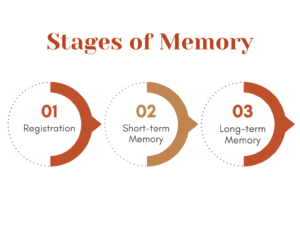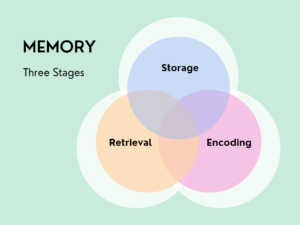Types and Biology of Memory, A Guide to Improve Memory
Guide to Improve Memory
As the name suggests, memory is a complex process that not only involves the brain but also includes other parts of the body. It is a vital part of our everyday life and enables us to focus on important things in our environment.

Types of Memory
- Below are the different types
Declarative Memory
Declarative memory is the ability to remember facts and events in your life. You use declarative memory when you remember what you did on your last birthday, or where you left your keys.
Episodic Memory
Episodic memory is the ability to remember past experiences and events. This type has three subtypes: episodic-situational, episodic-personal, and episodic-temporal. Episodic-situational memory involves recalling where a particular event or experience took place; it’s the most common form of episodic memory and one we use every day. Episodically remembering where you parked your car at the mall or how to get home from school is an example of an episodic-situational experience.
Episodically remembering what happened at work yesterday is also possible, though not as frequently since fewer specific moments stand out in our minds (unless we had a particularly interesting day). The ability for humans to remember personal information about themselves—what they ate for dinner last night, what color shirt they wore today—falls under this category as well.

Semantic Memory
This is the memory of facts and concepts. It’s stored in your temporal lobe, which means it’s highly associated with language comprehension and production. Semantic memory includes anything that comes from outside sources like books, magazines, newspapers, etc., as well as things you’ve read online or heard on TV.
Implicit Memory
Understanding the difference between explicit and implicit memory, as well as procedural and declarative memory can help you to improve your memory.
Explicit (declarative) memory is a type of long-term storage that is consciously accessible. This means we can recall information like names, places, facts, and events with ease.
Implicit (procedural) memories are learned unconsciously through experience or repetition. These types of memories include skills such as riding a bicycle or typing because you haven’t thought about them in years.
Procedural memories involve skills that we’ve practiced over time without consciously thinking about them; they are stored in our motor system so that our bodies know how to do something without thinking about it first. Declarative memories involve facts and events; these are stored in our sensory cortex so that we’re able to access them when needed for remembering names or places etc!
Episodic refers to personal experiences whereas semantic refers to general knowledge (facts). Episodic memories tend to be more vivid than other types of memories like semantic ones because they reflect what happened during those moments instead of being based on outside sources such as books/articles etcetera which can lead us astray into believing things happened differently than they did due
Working Memory
You probably know what working memory is, and you might think that by now, you’ve got it all figured out. You’ve got a pretty good idea of how it works and why it’s important. But here’s the thing: if you’re like most people, there are still ways to improve your working memory. There are still ways that you could be using your working memory better.
Working memory is the ability to keep information in mind while using it. If someone asks you a question (like “Where do we live?”), then answers his question (“We live in Missouri!”) while also asking another question (“How far away from home did we move?”) —that’s an example of working memory at work!
The capacity of working memory is limited; our brains can only hold so much information at once before something needs to go out or something else needs to come in if we want to continue learning new things or retaining old ones respectively. Working with this limitation means being aware when your brain is full—when there isn’t any room left for anything new—and then taking action on that awareness (e..g., writing down the name of a song lyric).

Long-Term Working Memory
Long-term working memory is a form of short-term memory that can hold information for extended periods. It is used to store and manipulate information for relatively long periods. It is used to support complex thinking and reasoning, and it is important for learning.
- Long-term working memory consists of multiple subsystems, including an articulatory loop that holds speech sounds; a visuospatial sketchpad, which holds spatial locations in the form of images; and an episodic buffer that allows people to recall multiple items at once (e.g., where I left my keys).
Long-Term Storage vs. Short-Term Storage
It’s important to know the difference between short-term and long-term memory because it affects how well you’ll be able to remember something. Short-term storage is temporary, meaning it can only hold information for a few seconds before it’s lost. Long-term storage is permanent and can hold information for much longer. Though these two types of memory may sound similar, they work differently:
- Short-Term Memory—This type of memory stores information from your senses until you need it again; then that information is transferred into long-term storage (if needed). Stored in short-term memory temporarily until it needs to be transferred or recalled.
- Long-Term Memory—Long-term memories last longer than short-term ones but still go away eventually unless they are repeatedly reinforced by retrieval practice (when an individual intentionally attempts to retrieve previously learned material). This type of memory includes episodic recollection such as remembering what happened yesterday; semantic remembrance such as knowing what food is healthy; and procedural knowledge like knowing how to ride a bike without thinking about each step involved in doing so (this is called muscle memory).
Four Brain Areas involved in memory
The hippocampus, amygdala, and cerebellum are the four major parts of the brain that are involved in memory storage. The hippocampus is a small organ in the medial temporal lobe (MTL) that encodes new information into short-term memory. The amygdala is an almond-shaped structure located deep within the MTL that helps store emotional memories from our past experiences. It also plays a role in processing fear, pleasure, anger, and other emotions by regulating hormones associated with these feelings. The memory size of the brain is unlimited
The cerebellum is located at the base of your skull behind your brain stem and controls balance and coordination as well as fine motor skills such as writing or buttoning clothes. The thalamus relays sensory information between various areas of our brains so we can perceive stimuli from our environment and process it through different areas of our brains for learning purposes.
Hypothalamus: This region processes hormones related to stress or sleep deprivation along with many other functions including hunger pangs or thirst signals depending on what type of food/drink we need at any given moment.[6] Prefrontal cortex: This region helps us make decisions based on previous experiences like how many people we trust most versus who we are related to (family vs friends); how long will it take before someone returns home after work? There are complex neural pathways for memory storage.
The Hippocampus and the Amygdala
The hippocampus and amygdala are two important parts of the brain, both involved with memory. The hippocampus is a part of the cerebral cortex that is responsible for memory and emotion. It has been shown to play an important role in processing information from short-term to long-term memory.
The amygdala is a small almond-shaped structure within the temporal lobe of your brain that plays a crucial role in processing memories related to emotional events by triggering responses like fear or pleasure. It also helps you learn about new experiences.
The hippocampus and amygdala are connected by the fornix, which transmits signals between these two areas via axons that run along its length.
Senses and the Amygdala’s Role in Emotion and Long-Term Storage
The amygdala is involved in emotional processing and the ability to remember emotional events. The amygdala also helps us recognize faces and facial expressions, which we use to understand other people’s feelings and intentions.
Because of its role in emotion, the amygdala can be thought of as a bridge between memory systems (explored later) that process sensory information and those that process emotions. For example, when you smell your favorite food or hear a song from your childhood, these pleasurable memories trigger an emotional response—you may feel happy or sad, nostalgic or joyful. If something bad happens while experiencing this sensation (you burn yourself while cooking), the trauma will likely be recorded by both auditory-visual pathways so you’ll remember exactly what happened as well as how you felt at that moment.
Memory Process
In the human brain, memory is a complex process that includes three basic steps: encoding, storage, and retrieval.

Memory can be defined as the ability to store and retrieve information from your long-term memory. This definition implies that there are two types of memory – short-term and long-term. For you to remember something for a longer period (short term), it must first be encoded into your short-term memory. Once these memories have been stored in your short-term memory you can then access them when necessary through various techniques such as rehearsal.
Memory research has found two main categories of encoding processes: Sensory encoding refers to sensory aspects of how we perceive experienced stimuli through our senses; Semantic encoding refers to how we encode meaning based on our prior knowledge or experiences with those stimuli
How the Brain Encodes Information into Memories
To understand how the brain encodes memories, we must first understand how it stores them. The brain is a complex organ that can do many things. For example, it can store memories through various senses and emotions. Information is encoded into memories through various senses and emotions. So, when you hear something or see something, your brain stores that information in your memory as an image or sound.
In addition to encoding information through sight and sound, there are other ways that people encode information into their brains’ long-term memory storage system (long-term).
A guide to improving your memory
- Follow these steps to improve your memory
Understanding your memory is key to improving it
To improve your memory, you first need to understand how it works.
- The first step is understanding the characteristics of your memory.
- This can be done by taking a free online questionnaire that tests for the different types of memory and gives an overall score on where you stand in terms of brain health and performance.
- Once you’ve established a baseline, you can begin improving your short-term recall with practice exercises designed specifically for that purpose.
Spaced learning; take breaks
Spaced learning is a time-based study system. The idea is that short bursts of studying will result in more retention of information than if you were to try and cram it all into your brain at once.
Spaced learning breaks down your learning into manageable chunks, which can be spaced out over time. This technique helps reduce forgetting and aids the process of remembering information for longer periods by increasing the number of times you review it.
Role of good sleep in memory
Sleep is a crucial part of the consolidation process. The brain needs to take time off from processing information and focusing on tasks, so it can repair itself and grow new cells. Sleep also helps us make connections between different memories, so we don’t forget them when we wake up.
If sleep deprivation happens regularly, you’re likely to see problems with your memory over time. Some researchers believe that getting less than seven hours of sleep per night could decrease IQ by 10 points after just one week!
Organize the information
The second step to improving your memory is to organize the information you want to remember in a way that makes sense to you. This could be as simple as making a list of words and their definitions, or it could be something more complex like using a mind map or concept map.
Organize the information on a page, in your notebook, or on your computer screen so that it’s easy for you to access when necessary. If possible, break down each chunk into smaller chunks so that they are more manageable pieces of information instead of large blocks of text (or images). Use repetition and practice for those smaller chunks to become familiar parts of your daily routine—this way when someone asks about something specific from class yesterday afternoon at lunchtime tomorrow morning when class resumes again!
Practice recall on a routine basis
Practice recall on a routine basis. The most important thing to improve your memory is to learn how to remember what you read and hear. To do this, you need to practice recall regularly until it becomes part of your daily routine. This way, when it comes time for an exam or presentation, those skills will be second nature!
Teach others
- Teaching others can help you remember things better.
- It is the best way to improve your memory in a very short time, if you want to learn a language or other subject then try to teach it to others in an interesting way so that they will understand easily and will also be interested in learning it.
Avoid distractions
- Multitasking is an illusion. When you try to do multiple things at once, your brain doesn’t know which one to focus on and so it becomes distracted by everything. This causes a loss of concentration, poor memory, and stress.
- Focus on one task at a time: If you need to study for an exam, don’t let yourself be distracted by anything else (like watching TV or talking on the phone). This can help improve your memory because you’re giving it 100% attention instead of dividing it among several activities. The more focused the mind is on something, the stronger that memory will be!
Active Reading vs passive reading
Active reading is when you read and take notes, while passive reading is when you just read without taking notes.
Advantages of active reading:
- You retain more information from what you are reading. This means that if a teacher assigns a book report on a book that they want us to understand, we can use the active/passive reading method to further our understanding of the material and make better sense of it in our own words.
- It helps us learn new information faster. For example, if I am trying to learn how to build an airplane or something similar for my job as an engineer at Boeing or Lockheed Martin (I’m not an engineer), I would use the active/passive method because it will help me remember all of this new information quicker than if I had just been passively learning about engineering without taking any notes during class or looking at examples online afterward during office hours before giving presentations tomorrow morning during which everyone expects me just know these things offhand!
Attach some emotional aspects to memory
The next time you want to remember a friend’s phone number, try attaching some emotional aspect to the memory. This can be done with the help of mnemonics (memory aids), which are usually visual images or stories. For example, if your friend’s name is John Carter and he told you that his birthday is next week, then you may make up a story about him being an astronaut who lands on Mars and finds himself lost in an alien world.
For this technique to work effectively, your association between the information and imagery must be strong enough so as not to fade away over time. Experts say that when we attach emotions to our thoughts, they become more likely to stay in our minds without fading away into oblivion
Role of Brain games and brain exercises
Various brain games can help to improve focus and memory. Nowadays these are in the form of mobile applications. However, mobile itself can be a source of distraction.
What is the role of Mental illness in memory disturbance
- Depression and anxiety can affect memory. cognitive decline can be an important symptom of depression.
- There is a disturbance in mental function in others with mental illnesses as well
- Mental illness can cause amnesia, which is the inability to remember events or episodes from our life.
- Dementia is another type of mental illness that may cause severe memory loss in some people.
- The risk of dementia increases with other brain diseases. rate of memory decline is more in dementia.
Role of medicine to improve memory
The first step is to look for the reason for memory disturbance. There are many types of medicine to improve memory, such as medicines that improve focus, medicines that improve attention, and medicines that improve thinking and learning. Some of these may also help with your mood or sleep.
If you have a medical problem with one or more brain functions (memory, attention, thinking), it is important to talk to your doctor about whether any drugs will be helpful for you. Some medications can help with memory problems in people who have other health conditions such as depression and anxiety disorders.
If you are taking any drugs for a medical condition, talk to your doctor about whether any side effects could affect your memory.
Risks of overuse of brain stimulants
The use of brain stimulants can be very harmful, especially when it is used in excess.
When you are overusing your brain stimulants, you may experience some common side effects such as:
- Headaches and migraines
- Insomnia (trouble sleeping)
- Depression or mood swings
Conclusion
The brain is the most complex organ in our body, and memory is one of its most important functions. Understanding the biology of memory can help us understand how our brains work, and what we can do to improve them.

